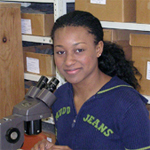 PhD Student | Department of Anthropology
PhD Student | Department of Anthropology
University of Florida
Advisor: Dr. Susan D. deFrance
Florida Museum of Natural History
Research Interests
My interests are in the season of occupation of shell mound sites of the Southeastern United States during the late Archaic cultural period. My research involves the application of sclerochronological techniques to document the periodicity of shell formation in modern specimens of the eastern oyster (Crassostrea virginica) in order to establish a proxy for seasonal use of oysters in the archaeological record. I am currently working on oysters from a shell ring located on St. Catherine’s Island Georgia.
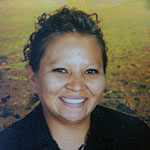 Graduate Student | College of Education
Graduate Student | College of Education
University of New Mexico
Advisor: Gary Morgan
Florida Museum of Natural History
Research Interests
My primary concentration of study includes biology. I began volunteering for Gary Morgan at the NMMNH in 2009. At the same time Dr. Thomas Williamson was looking for a Native American student to mentor in the sciences. He invited me to work for him on mammals from the paleocene. Shortly thereafter, I began my field experiences in the San Juan Basin collecting matrix, screen washing, picking and sorting micro fossils. I began working with Gary Morgan in January of 2011. Currently, I am working with Gary Morgan on miocene fossils. I screen wash, pick and sort micro fossils for him. Gary is also mentoring me in fossil identification and their ecology. My primary focus is to integrate the sciences with hands on experiences inside the classroom by collaborating with researchers and scientists.
Contact Information
University of New Mexico
College of Education
Albuquerque, NM 87131
Email
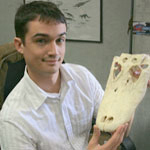 PhD | Department of Geological Sciences
PhD | Department of Geological Sciences
University of Florida
Postdoctoral Fellow, Geiseltalmuseum
Zentralmagazin Naturwissenschaftlicher Sammlungen
Martin-Luther-Universität Halle-Wittenberg
Halle (Saale), Germany
Research Interests
I am interested in addressing questions regarding the evolution and biogeography of crocodilians in the New World Tropics throughout their geologic history. Fossils from the Panama Canal provide a unique opportunity to determine the evolutionary transitions between alligators and caimans. In addition, research may lend support to the concept of a tropical refugium for primitive taxa within the ancient Panamanian environment. I am also interested in whether crocodilians in Panama at this time represent North American, South American, or mixed fauna in order to address issues regarding possible competitive exclusion.
Selected Publications
Hastings, A.K., J.I. Bloch, C.A. Jaramillo, A.F. Rincon, B.J. MacFadden. 2013. Systematics and Biogeography of Crocodylians from the Miocene of Panama. Journal of Vertebrate Paleontology, 33(2):239–263.
Published Abstract: Hastings, A., B. MacFadden, A. Rincon, C. Montes, and C. Jaramillo. 2009. Filling in the Central American crocodile gap: Evidence from the middle Cenozoic of Panama. Journal of Vertebrate Paleontology 29 (3, Suppl.):111-112A.
 PhD | Department of Biological Sciences
PhD | Department of Biological Sciences
University of Florida
Research Interests
My research focuses on the evolutionary origin of the South American rainforests by looking at plant macrofossils. I am interested to know when and how the tropical rainforests appeared in the Neotropics, what mechanisms have produced the high species diversity and the characteristic family composition. I want to reconstruct the paleoclimatic, paleoecological and paleobiogeographical conditions under which the ancient Neotropical rainforest flourished, particularly during the Late Cretaceous, Paleogene and Miocene. I am also interested on the systematic and taxonomy of Neotropical fossil plants.
Publications
Fabiany Herrera, Steven R. Manchester, Carlos Jaramillo, Bruce MacFadden and Silane A. da Silva-Caminha. 2010. Phytogeographic History and Phylogeny of the Humiriaceae, Int. J. Plant Sci. 171(4):392-408.
Wing, S.L., Herrera, F., Jaramillo, C., Gomez, C., Wilf, P., and Labandeira, C.C. 2009. Late Paleocene fossils from the Cerrejón Formation, Colombia, are the earliest record of Neotropical Rainforest. PNAS 106: 18627-18632.
Fabiany A. Herrera, Carlos A. Jaramillo, David L. Dilcher, Scott L. Wing and Carolina Gómez-N. 2008. Fossil Araceae from a Paleocene neotropical rainforest in Colombia. American Journal of Botany 95(12): 1569-1583.
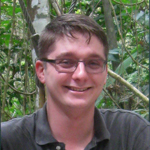 Master’s Student | Department of Geological Sciences
Master’s Student | Department of Geological Sciences
University of Florida
Advisor: Dr. David Foster
Research Interests
My research involves investigating the tectonics behind the formation of the Isthmus of Panama. Specifically, I’m investigating the uplift and exhumation in the Azuero Peninsula area with low-temperature thermochronology data. Recent evidence points to periods of late stage uplift, and my research seeks to investigate the timing and extent of this uplift and how it may connect to final closure of the isthmus.
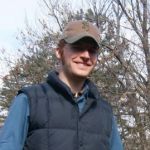 PhD Student | Department of Biology
PhD Student | Department of Biology
University of Florida
Florida Museum of Natural History
Advisor: Dr. David Steadman
Research Interests
Ornithology, paleornithology, systematics, biogeography, and paleoecology. Specifically I would like to investigate the phylogenetic history of avian taxa in the New World Tropics and the role of birds in the Great American Biotic Interchange. I am also interested in the outreach component of PCP-PIRE.
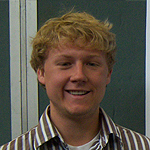 Masters Degree | Department of Geological Sciences
Masters Degree | Department of Geological Sciences
University of Florida
Florida Museum of Natural History
Advisor: Dr. Bruce MacFadden
Research Interests
I have interests spanning the wide range of topics within the vertebrate paleontological spectrum and am still exploring possible research avenues. Much of my research thus far has focused on vertebrate paleoecological changes with respect to space and time. Fossiliferous deposits in Panama and Florida help document the Great American Biotic Interchange which offers a truly unique forum for studying these changes during and after the formation of the Isthmus of Panama.
Contact Information
Florida Museum of Natural History
Museum Road & Newell Drive
Gainesville, FL 32611
Email
 PhD Student | Department of Geological Sciences
PhD Student | Department of Geological Sciences
University of Florida
Florida Museum of Natural History
Advisor: Dr. Bruce MacFadden
Research Interests
My research interests broadly encompass the evolutionary history of sharks and how changing environments and climate impact this ecologically vital group. Currently, I am interpreting the paleoenvironment of a site in Panama based on the fossil shark and stingray specimens found there. This site is particularly interesting because it was deposited during a dynamic time in Earth history prior to the uplift of the Panamanian isthmus, which means there was still a connection between the Caribbean Sea and the Pacific Ocean. My goal is to develop an understanding of the marine communities across the Central American Seaway through the implementation of taxonomic composition, functional morphology, and isotope geochemistry. In congruence with this, I seek to take this research and incorporate it into classroom lessons in order to deepen student understanding of paleontology and increase interest toward careers in science.
 Masters Degree | College of Journalism and Communications
Masters Degree | College of Journalism and Communications
University of Florida
Advisor: Dr. Debbie Treise
Florida Museum of Natural History
Advisor: Dr. Doug Jones
Research Interests
I am a science educator and communicator with special interest in developing strategies to make science understandable to the general public.
 PhD Student | School of Natural Resources and Environment
PhD Student | School of Natural Resources and Environment
University of Florida
Florida Museum of Natural History
Advisor: Dr. David L. Reed and Dr. Scott Robinson
Research Interests
My research interest focuses on the ecology and evolution of parasites and infectious diseases. More specifically, I am driven by questions surrounding how disturbance to the ecosystem (e.g., deforestation, development of water management systems, hurricanes) affects parasites and infectious diseases on a landscape scale. Additionally, I am interested in looking at how climate change is impacting the vector population and, as a result, the vector-borne parasites that may increase the risk of infection for wildlife and human populations in the Neotropics (e.g., dengue virus, malaria).
In addition to my research, my dissertation and career is deeply involved in: 1. Getting the general public interested in science, and 2. Increasing science literacy across all age groups. The first step to approaching these mammoth-sized goals is to get grade school and high school students excited about science. For my dissertation, I plan to work with Panamanian teachers, scientists, and local schools in developing science modules and mentoring programs.
Contact Information
Florida Museum of Natural History
Museum Road & Newell Drive
Gainesville, FL 32611
Email
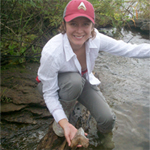 ePhD Student | UF Department of Biology
ePhD Student | UF Department of Biology
University of Florida
Florida Museum of Natural History
Panama | Smithsonian Tropical Research Institute
Advisor: Dr. Bruce MacFadden
Research Interests
- Biology, particularly shark’s paleoecology, development, migrations routes, population ecology and conservation.
- Science Education in biology and paleontology and distribution of scientific information to kids using technology. Public outreach products: http://stri.org/english/kids/sharks/
Publications
Pimiento C. and Pringle R. 2011. Fossil sharks: Learning from and about the past. Science Scope 34 (6) 52-59.
Pimiento C., Ehret DJ, MacFadden BJ, Hubbell G (2010) Ancient Nursery Area for the Extinct Giant Shark Megalodon from the Miocene of Panama. PLoS ONE 5(5): e10552. doi:10.1371/journal.pone.0010552.
Uhen, M.D., Coates, A.G., Jaramillo, C.A., Montes, C., Pimiento, C., Rincon, A., Strong, N., Velez-Juarbe, J. (2010) Marine mammals from the Miocene of Panama, Journal of South American Earth Sciences. doi: 10.1016/j.jsames.2010.08.002.
Contact Information
Florida Museum of Natural History
University of Florida
Email
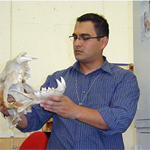 PhD Candidate | Department of Biology
PhD Candidate | Department of Biology
University of Florida | Florida Museum of Natural History
Advisor: Dr. David Reed
Website: www.jorgepino-panama.weebly.com
Funds provided by:

Research interests
My research interests focuses on the evolutionary history of modern mammals in the Neotropics. I am interested on studying mammalian phylogeographic patterns in montane and insular environments in Panama and learn about the processes that promoted current diversity.
More broadly, I am interested in strengthen the collaboration between international and Panamanian learning/research institutions and the promotion of building local capacity. Specifically, I am interested on facilitating the involvement of Panamanian students in current research projects, envisioning their future to engage in graduate programs.
Selected Publications
Pasch, B. and J.L. Pino. 2013. Cost of advertising: Long-tailed weasels (Mustela frenata) as potential acoustically-orienting predators of Neotropical singing mice (Scotinomys). The Southwestern Naturalist 58(3):363-366.
J.L. Pino. 2013. Primer Simposio de Paleontología de vertebrados de Panamá Avances en el conocimiento de la paleontología de vertebrados en Panamá: Intercambios y conexiones Neotropicales. Puente Biológico 5: 87-96.
J.L. Pino, M. Ascunce, J.P. Hugot, D. Reed. 2012. Development and characterization of novel polymorphic microsatellite markers for the endangered Laotian rock-rat (Laonastes aenigmamus) using 454-sequencing technology. Conservation Genetics Resources 4:999–1002.
Campbell, P.; Pasch, B.; Pino, J.L.; Crino, O.; Phillips, M. and Phelps, S.M. 2010. Geographic variation in the songs of Neotropical singing mice: testing the relative importance of drift and local adaptation. Evolution 64-7: 1955–1972.
Contact Information
Florida Museum of Natural History
Dickinson Hall | Gainesville FL 32611-7800
Phone: (352) 273-2114 | Email
 Masters Degree | Department of Geological Sciences
Masters Degree | Department of Geological Sciences
University of Florida
Florida Museum of Natural History
Advisor: Dr. David Foster
Research Interests
Modern and ancient sedimentary basins preserve the record of exhumation and erosion events of mountain belt systems. My research focuses on the integration of stratigraphic techniques, geochronologic and isotopic data and low-temperature thermochronology analysis of detrital minerals to determine the timing of tectono-thermal events that led to mountain building and erosion in central and eastern Panama.
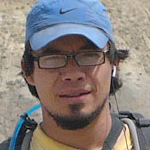 PhD Candidate | Department of Geological Sciences
PhD Candidate | Department of Geological Sciences
University of Florida
Florida Museum of Natural History
Advisor: Dr. Jonathan I. Bloch
Research Interests
I am working on the biostratigraphy and geochronology of newly collected late Oligocene?-early Miocene land mammal fossils from the Panama Canal Area. These fossils, mostly ungulates, represent the oldest fossil association in areas related to the ACP (Autoridad del Canal de Panama) Expansion Project. Elucidating their evolutionary history, interactions, and relationships will lead to new interpretations about the paleobiogeographic evolution of the Neotropic and its relationship with other fossil mammals in North America.
Selected Publications
MacFadden, B. J., J. I. Bloch, H. Evans, D. A. Foster, G. S. Morgan, A. F. Rincon, and A. R. Wood. 2014. Temporal Calibration and Biochronology of the Centenario Fauna, Early Miocene of Panama. The Journal of Geology, 122(2):113–135.
Rincon A. F., J. I. Bloch, B. J. MacFadden, and C. Jaramillo. 2013. New record of Arretotherium (Mammalia, Anthracotheriidae, Bothriodontinae) from the Early Miocene Las Cascadas Formation, Panama. Journal of Vertebrate Paleontology, 33:421-433.
Hastings, A. K., J. I. Bloch, C. A. Jaramillo, A. F. Rincon, B. J. MacFadden. 2013. Systematics and Biogeography of Crocodylians from the Miocene of Panama. Journal of Vertebrate Paleontology, 33:239-263.
Rincon, A. F., J. I. Bloch, C. Suarez, B. J. MacFadden, And C. A. Jaramillo. 2012. New Floridatragulines (Mammalia, Camelidae) from the Early Miocene Las Cascadas Formation, Panama. Journal of Vertebrate Paleontology 32(2):1-20.
Head, J., A. F. Rincon, C. Suarez, C. Montes, and C. Jaramillo. 2012. Fossil evidence for earliest Neogene American faunal interchange: Boa (Serpentes, Boinae) from the early Miocene of Panama. Journal of Vertebrate Paleontology 32: 1328-1334.
Cadena E. A., J. R. Bourque, A. F. Rincon, J. I. Bloch, C. Jaramillo, and B. J. MacFadden. 2012. New turtles (Chelonia) from the late Eocene through late Miocene of the Panama Canal Basin. Journal of Paleontology, 86:539-557.
MacFadden, B. J., M. Kirby, M, A. F. Rincon, C. Montes, S. Moron, N. Strong, and C. Jaramillo. 2010: Extinct peccary “Cynorca” Occidentale (Tayassuidae) from the Miocene of Panama and correlations to North America. Journal of Paleontology 84(2): 288-298.
Uhen, M., A. Coates, C. Jaramillo, C. Montes, C. Pimiento, A. Rincon, N. Strong And J. Velex-Juarbe (2010). Marine mammals from the Miocene of Panama. Journal of South American Earth Sciences 30:167-175.
Rincon, A., Bloch, J., MacFadden, B., Suarez, S., Carlos, J. (2010), New Early Miocene camelids from the Las Cascadas Formation, Panama Canal, Central America. 70th Society of Vertebrate Paleontology Meeting. Pittsburg, PA. USA.
Rincon. A., Montes. C, Jaramillo. C, MacFadden. B, Cardenas. M & Rodriguez. C. (2008) Nuevos hallazgos de vertebrados del Neógeno en las obras de ampliacion del Canal de Panama. Republica de Panama. III Congreso Latino Americano de Paleontología de Vertebrados. Neuquen, Argentina.
Contact Information
224 Dickinson Hall
Museum Road & Newell Drive
Gainesville, FL 32601
Email
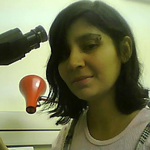 Research PhD Student
Research PhD Student
Department of Earth Sciences Royal Holloway
University of London | Surrey, UK.
Advisor: Dr. Howard Falcon–Lang
Funds provided by:

Research Interests
- Paleobiology and Paleobotany
- Taxonomy of fossil plants based on wood anatomy and leaf morphology
- Historical evolution and biogeograpical patterns of plants
Published Abstracts
Rodríguez- Reyes, O., Calvillo- Canadell, L. y Cevallos-Ferriz, S.R.S., 2009. Material foliar del Eoceno de la Formación Carroza, La Popa, Nuevo León, México. XI Congreso Nacional de Paleontología. Juriquilla, Querétaro, Qro.
Rodríguez-Reyes, O. y Cevallos-Ferriz, S.R.S., 2008. Material Foliar del Eoceno del Noreste de México. La Popa, Nuevo León. Boletim de resumos. XII Simpósio de Paleobotánicos e Palinólogos. Florianópolis, SC, Brasil, 2 a 5 de novembro de 2008. www.ufrgs.br/xiisbpp.
Calvillo-Canadell, L., Castañeda-Posadas, C., Estrada-Ruiz, E., Rodríguez-Reyes, O., Sainz-Resendiz, A., y Cevallos-Ferriz, S.R.S., 2008. Plantas fósiles y el proceso de diversificación de la vegetación en México: aparición de las zonas áridas de México. 1er. congreso “Diversidad biológica y cultural en la reserva de la biosfera Tehuacán-Cuicatlán”.
Contact Information
Department of Earth Sciences Royal Holloway
University of London Egham Hill | EGHAM | TW20 0EX
United Kingdom
Email